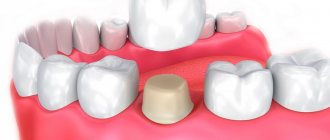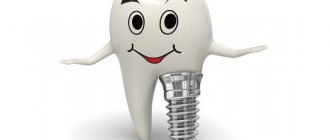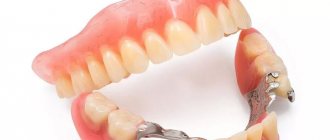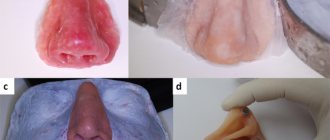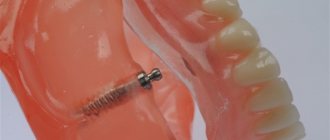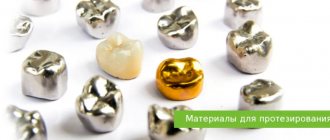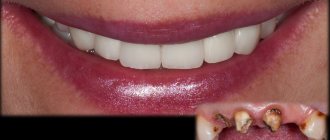A combined crown is a structure consisting of a metal base and a shell. A composite composition, plastic or ceramics is used as an external coating. The color and texture of the shell is matched to the parameters of natural dental elements. The frame is made of stainless steel or alloys of cobalt and chromium, nickel and chromium. The crown is made using stamping or casting. The thickness of stamped dentures is from 0.3 mm. For cast bases, the thickness reaches 0.4-0.5 mm. Frames of the low price segment are created from dental sockets made of stainless steel. A standard sleeve is taken, broached and forged on a die created from an impression from the problem tooth. When making a cast base, an impression is taken from the dental element and a wax model is made. The internal diameter of the correct frame should exceed the diameter of the tooth stump by 50-100 microns. This guarantees the strength of the connection between the microprosthesis and the element. Cast structures have the specified accuracy. Bases for ceramic or composite cladding are made using standard technology. Today, adhesive liquids are used to create a strong bond between the metal substrate and the plastic. The thickness of the surface layer depends on the material and location on the crown (in the cervical, cutting or central part). To prevent the base from showing through the ceramic layer, white varnish or yellow titanium nitride is applied on top. The popularity of prostheses made of gold alloys is due to biocompatibility and lack of translucency. The veneer performs an aesthetic function and is applied to the vestibular surface.
Metal and plastic
These are inexpensive crowns that have been placed on the front teeth for decades.
The metal base was covered with an inert synthetic. But time has shown the conventional aesthetics of the structures - over time, the coating darkened and the metal became visible. After a couple of years, a painful replacement of the prosthesis was required. Today, metal-plastic crowns are cheap and can be used for the restoration of molars. But their aesthetic life is maximum 3 years. Therefore, this option is recommended as temporary. Before permanent prosthetics during implantation or in other cases when it is impossible to install a permanent prosthesis immediately after treatment.
Indications
The use of combined microprostheses is indicated for all dental defects that require a prosthetic procedure. The products are used for units visible when smiling and during speech. We are talking about the frontal units and premolars of the upper jaw.
Combined microprostheses are indicated in the presence of defects:
- Unit mobility.
- Severe destruction of the supragingival part of the element, which is not spread by filling or using inlays.
- Irreversible change in enamel shade.
- Reduced height of the lower third of the face due to increased wear of dental elements.
- Edentia.
Can be used for implantation and other clinical situations.
Zirconium dioxide and ceramics
Such dentures are flawless and are recommended for installation on the front teeth. The units are stronger than natural ones due to the stable zirconium frame, and the ceramic coating gives them a visual naturalness, ensuring correct light reflection.
But such a tooth crown is expensive. And it’s not always justified. Modern solid ceramics are close in strength to natural enamel. Therefore, in most cases, frameless ceramics, which are indistinguishable from natural units, are chosen for the restoration of the beauty area.
In addition, Cerec porcelain crowns for front teeth can be made within 1.5 hours; the price of this option is more affordable and its aesthetics are high. The artificial units created using innovative equipment will be flawless, you don’t need to get used to them - their parameters are calculated by a computer program taking into account the anatomical characteristics of a particular patient.
Reviews
Today, the combined crown can be called “folk” due to its popularity. The time of fashion for gold “fixes” is irrevocably passed.
The main question that worries patients is how long can crowns lined with various materials last? If you have your own experience in this regard, please share it with visitors to our site. The comment form is at the bottom of the page.
If you find an error, please select a piece of text and press Ctrl+Enter.
Tags dental crowns fixed dentures
Did you like the article? stay tuned
Previous article
Teeth analogues from the Japanese company Yamahachi are the best solution for removable prosthetics
Next article
Relevance of neuromuscular dentistry
Metal ceramics
If it is necessary to replace molars, ceramics will not be suitable; the material is too fragile and will not withstand the increased load. Therefore, it is more reasonable to install metal-ceramic or zirconium crowns on chewing teeth. The last segment is more expensive. Therefore, many patients choose a metal cast crown coated with ceramics.
Modern frames are made only by casting. This ensures a tight fit of the crown in the remains of the natural tooth, preventing the entry of pathogenic microflora into the tooth.
Contraindications
Relative
the procedure can be carried out with extreme caution
- Bite defects;
- increased abrasion of the enamel of the antagonist tooth;
- gum pathologies (atrophic, inflammatory);
- pregnancy;
- allergy to anesthetics;
- acute infections;
- mental disorders;
- exacerbation of a chronic disease.
Absolute
the procedure is strictly prohibited
- Severe periodontitis with tooth mobility grade III-IV;
- malignant processes of the oral cavity;
- allergy to prosthesis material;
- decompensated diabetes mellitus.
When are combined crowns installed?
Metal-ceramics can be installed if a large tooth crown is destroyed; the frame will protect the remains of the molars from excessive loads.
Metal ceramics are installed:
- For a real tooth with a healthy, strong root that has crumbled by 50% or more.
- As part of the bridge structure - crowns on the supporting teeth.
- As a final prosthesis on implants.
The option is quite worthy for maintaining the function of chewing teeth and helping to preserve the structure of periodontal tissues.
But in general, if a tooth is more than 50 percent damaged, it is more advisable to install a Cerec module, and the tooth restored in this way will serve you for many more years.
Price issue
The cost is determined mainly by the cladding material (not counting products made of precious metals). Depending on it, the price of microprosthetics can range from several to 2 tens of thousand rubles.
The table shows approximate prices for lined structures. But you need to understand that if you want, you can always find an option a couple of thousand cheaper than the market average.
| Type of crown | Cost, rub. | Features of the instructions |
| Metal-plastic | From 2 500 | Frame made of dental socket (stainless steel) |
| Metal composite | From 7 000 | Material GC Gradia or TwiNY |
| Metal-ceramic | From 8 000 | Nickel-chrome alloy frame |
| Metal-ceramic | From 18 000 | Gold frame |
Advantages
Due to the metal base, combined crowns are stronger than real teeth. With proper care, their service life is 15 years
.
Additional advantages:
- They do not lose their shape or shade.
- Visually close to natural enamel. Therefore, they are invisible against the background of neighboring molars when laughing or talking.
- Reliable protection and functionality - you can safely chew your usual food.
- The risk of allergies is minimal (traditionally, up to 2% of people are sensitive to alloys).
When installed correctly, it adheres to the gum and tooth, protecting the units
Life time
The service life of veneered products is determined by several factors, including the type of lining material, the professionalism of the doctor, the accuracy of technology, and care of the oral cavity after prosthetics.
The approximate service life of combined models, depending on the type of cladding, is:
- for metal ceramics – 10-15 years;
- for metal composite products – from 5 to 15 years, depending on the grade (brand) of the composite;
- for metal-plastic structures – up to 5 years.
Failure can occur for various reasons. If for metal-plastic products the main danger is the separation of plastic from the metal, then for composite and ceramic products it is cracks and chips.
While composite products can be repaired in the patient's mouth, with metal ceramics there is no other way to correct the problem other than replacing the crown. The same can be said about metal-plastic microprostheses. Detachment of the lining will inevitably lead to food getting underneath and rotting. Therefore, the sooner the prosthesis is replaced, the better.
Manufacturing and installation of combined crowns
To put a metal-ceramic crown on your teeth (cost – 17,900 rubles / tooth), it will take 7-14 days
.
Manufacturing sequence:
- The tooth is prepared to the thickness of the crown.
- An impression is taken from which a cast crown is made.
- It is advisable to install temporary plastic protection on treated teeth.
- A metal frame is made and tried on.
- If adjustments are needed, they are made, and another fitting follows. When the artificial tooth fits, the metal is coated with ceramic.
- During installation, the tooth is covered with a protective compound, and the prosthesis is fixed with dental cement.
A nuance: the ceramics are applied in layers, each layer is baked in an oven under high temperature. Therefore, the coating is stable and securely attached to the metal base. Contact me at the dentist and we will decide what crown to put on the tooth in your case.
Product characteristics
Combined crowns are those consisting of a metal base (frame) and a non-metallic lining applied to it.
These designs represent a compromise between functionality and aesthetics. Metal makes products durable, not subject to cracks and destruction; the facing material gives them a look similar to natural enamel.
The production of combined crowns consists of two stages:
- stamping or casting of a metal frame;
- lining it with ceramics, plastic or composite.
Frame
Dozens of grades of noble and base metals and their alloys have been developed for the manufacture of frames of combined models.
The most commonly used materials are:
- Cobalt-chrome alloy. The material has high strength and rigidity, which makes it possible to make the frame thin - 0.3-0.4 mm. But its casting properties are low, and its high rigidity makes stamping difficult.
- Nickel chrome alloy. It has good casting characteristics, but due to low rigidity it requires a frame thickness of 0.4-0.5 mm.
- Stainless steel.
- Titanium and its alloys.
- Noble metals - platinum or gold and their alloys.
It is advisable to use materials containing gold for manufacturing hidden under the lining of the frame for two reasons - due to the high biological compatibility with human tissues, and the yellow color, which does not show through from under the lining.
To obtain the required aesthetic effect, gold alloys can be replaced with base metals coated with titanium nitride (“gold-like”).
The thickness of the frame wall should not be less than 0.3 mm. Metal bases are made by stamping or casting. Stamped structures are cheaper, but solid ones have a number of advantages:
- They are more accurately adjacent to the stump. This makes the fixation more reliable, since a thin layer of glue holds better than a thick one.
- They are less subject to deformation than stamped ones , which increases the strength of fastening of the cladding to the base.
- It is possible to manufacture a frame with a ledge for facing material. This eliminates the traumatic effect of the microprosthesis on the gums.
- Cast structures can be cast together with bridge prostheses. Stamped types have to be connected to MP soldering, which is undesirable due to the chemical reaction of the solder to certain substances contained in saliva.
The technology for manufacturing cast and stamped frames at the first stages is the same and provides for:
- turning the tooth;
- taking impressions from it and antagonist teeth;
- making plaster models from casts;
- checking them on an occluder.
Further production of stamped and cast bases differs. The first ones are usually made from dental sockets. To do this, a metal die (mold) is cast using a plaster model, on which a metal crown is forged using free forging.
To produce a solid-cast frame, wax modeling and casting of the product from a nickel-chrome alloy or other metal is performed.
Facing
Ceramics and plastic composite are used as cladding.
The most widely used is ceramics, which can have different properties depending on its composition.
Ceramics based on lithium disilicate and leucite and aluminum-magnesium spinel have good strength properties.
Alternative Methods
Ceramic-composite metal-free, lightweight crowns with high light transmittance
Zirconium Durable crowns with high aesthetics, suitable for anterior and posterior teeth
Cast Durable and durable one-piece crowns made of metal alloys with the possibility of veneering
Article Expert
Shirokov Ivan Yurievich Dentist-orthopedist, doctor of the highest category
Work experience: more than 17 years
